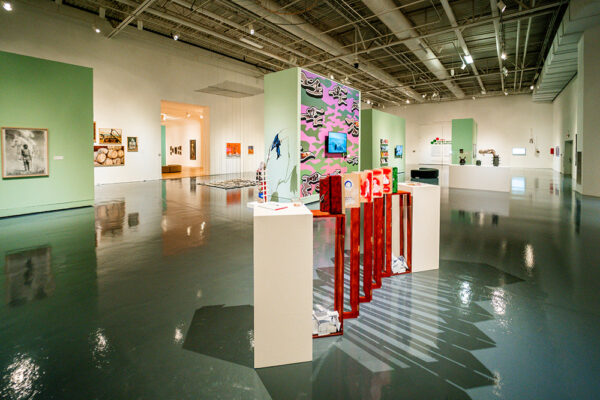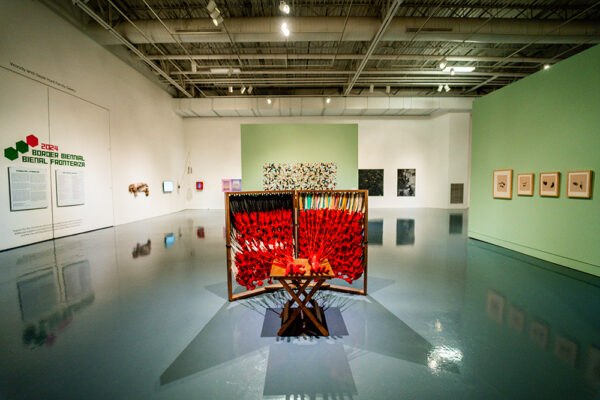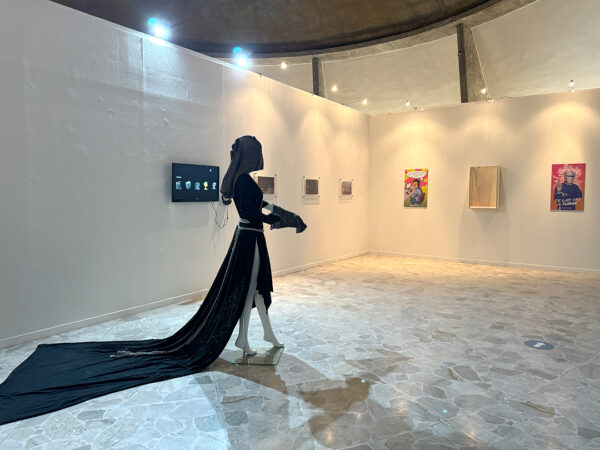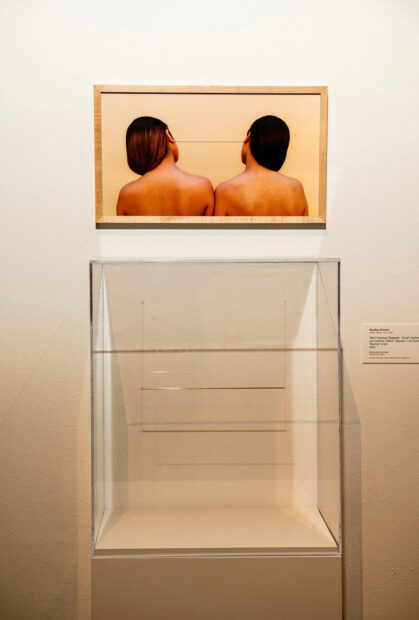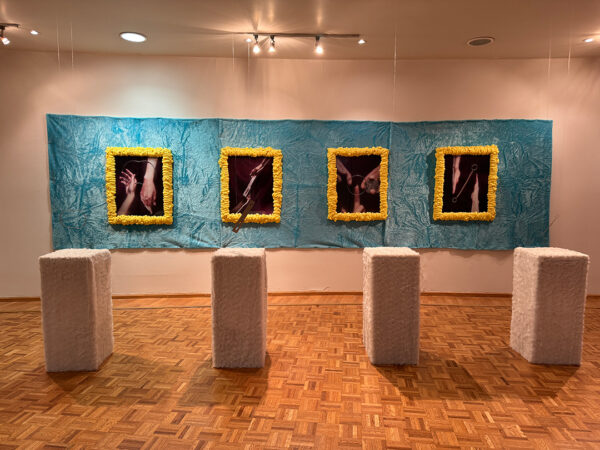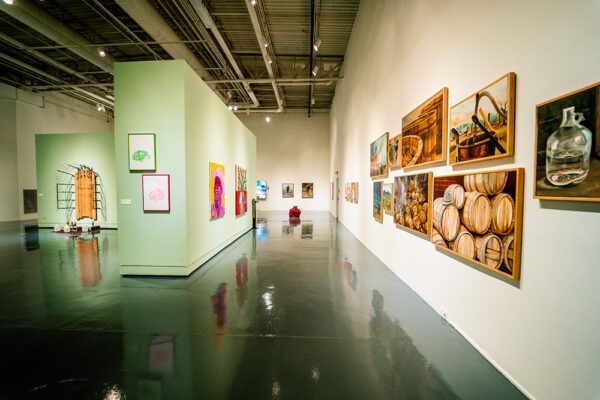It is a daunting task to sum up an exhibition featuring 50 artists, and it’s perhaps made more difficult by the fact that the 2024 Border Biennial / Bienal Fronteriza 2024 spans two museums in two countries. Hosted by the El Paso Museum of Art (EPMA) and El Museo de Arte de Ciudad Juárez (MACJ) and curated by Claudia S. Preza M.A., EPMA Assistant Curator, with curatorial advisors Edgar Picazo Merino and Jazmín Ontiveros Harvey, the exhibition presents the diverse experiences and perspectives of artists living within a 200-mile radius of the U.S./Mexico border. Among the artists are familiar names of Texas-based or Texas-born creatives such as Gil Rocha, Alejandro Macias, and Beili Liu. But, for the sake of this review, I am narrowing my focus to a few artists who were new to me and whose work stood out in what is an impressive exhibition filled with talented artists.
Nortejiendo
On its website, Nortejiendo describes itself as “a platform for artistic and creative expression,” though during my trip to El Paso, many people referred to the group as an artist collective. Established in 2017, the collective consists of Isis Estrada Rascón, Laura María Acosta Navarro, Natalia Barragan Orozco, and Oscar Francisco Solís Rodríguez. Nortejiendo states that their work is in defense of human rights and is at the intersection of activism, urban intervention, and art. At EPMA, the group’s installation, Desaparecer no es Normal (Disappearing is not Normal), is the first piece to confront viewers as they walk into the gallery.
A pair of blood-red fabric sculptures of hands sit palm up on a wooden folding table. Each is attached with red threads to cloth strips hung on wooden frame-like panels. One panel holds 3,542 colorful strips, each representing a missing person from the Mexican state of Chihuahua. The other panel holds the same number of black and white cloth strips, representing the individuals’ families. When the hands are lifted the fabric is pulled, making the installation a visceral reminder of the connectivity between all people. As I stood in front of the work, the words of Mamie Till-Mobley, the mother of Emmett Till, ran through my mind: “…what happens to any of us, anywhere in the world, had better be the business of all of us.”
In MACJ’s presentation of the biennial, which due to space limitations only includes 30 of the EPMA artists, Nortejiendo has a two-part installation. Tu Odio Me Mata (Your Hatred Kills Me) features a mannequin staged with a textile piece used during a performative work, and an adjacent human form made of textile pieces. The soft sculpture is made of small fabric swatches ranging from light to dark gray and has a heart made of colorful yarn. The nearby mannequin wears a dark gown with a long train, a hood over its head, and coverings over its hands.
The piece speaks to the ways in which people who do not fit within the cisgender heterosexual identity are often forced to hide their sexual orientation and gender identity. On a podium near the work, Nortejiendo has provided a visual aide that indicates a range of actions that people who identify as LBGTQ+ encounter. These are referred to as Efforts to Correct Sexual Orientation and Gender Identity and include things like hurtful jokes, public humiliation, hitting/torturing/punishing, sexual abuse, and homicide/murder.
Haydee Alonso
In sharp contrast to Nortejiendo’s installations, Haydee Alonso’s “Bad” Hyphens Separate; “Good” Hyphens Attach, at the end of the EPMA exhibition, spoke to the precarious nature of border relations with a more subtle approach. The work masquerades as a simple jewelry piece — a long, thin, sterling silver and brass rod — and is displayed alongside a photograph of a pair of women wearing the piece, which effectively tethers them to each other’s ears. The beauty of both the metal rod and the image is quiet and captivating, but the longer I stood in front of the work, the more it made me squirm. In the photograph, the women standing shoulder to shoulder (and who are attached ear to ear) are each pulling their head slightly away from the other. Though their ears do not appear to be in danger of ripping or tearing, there is a tension building. Are they already in pain? Are they on the brink of injury?
The work’s title evokes the idea of living a hyphenated existence. As a Mexican-American, I have had a lifelong struggle with being a hyphenated American. In some ways, it can feel as if my identity is seen as less than, as not fully American. Though physically small, the hyphen creates an ocean of separation. In other ways, I never want to be seen as just one or the other, because I am both. This push and pull lives in my brain and being, always. At the opening of the MACJ biennial I had the chance to briefly talk with Alonso. She spoke of her desire to activate the jewelry as a performance, with two women wearing the earring and walking through the EPMA galleries. The metal work and photograph alone are strong pieces, but I imagine that seeing it come to life — witnessing the delicate dance of two people being connected in such an intimate, yet perilous, way — would propel the piece further.
At MACJ, Alonso’s installation included four metal pieces and their photographic counterparts. Cozen consists of a set of four pedestals, each of which is covered in white cloth and has a precarious-looking metal piece hanging above it. On the wall behind the pedestals are photographs of hands that show how the metal pieces are meant to interact with the human body. The images are framed with yellow foam insulation, and a large blue rectangular cloth forms a backdrop for the works. Each of the pieces seem to be built to comment on connection. For example, on the far left, what looks to be a combination ring and bracelet serves to separate and confine rather than bring together.
Alonso’s work is at once alluring and distressing. A statement on the artist’s website (which is an English translation of the Spanish label text from the MACJ exhibition) explains, “Ciudad Juarez and El Paso are not sister cities. Not when the United States cuts off gas supplies to Mexico in the middle of arctic conditions: leaving almost five million Mexicans without power. The blurring of borders, something that I so firmly believed in, does not exist.”
Veronica Ibargüengoitia
In the corner of one of the interior gallery spaces at EPMA, Veronica Ibargüengoitia’s Universal Moving leans against a wall. The work seems to be an innocuous stack of cardboard moving boxes, but upon closer inspection it becomes clear that the exterior of the boxes have been printed by the artist. Although from a distance this print looks like a typical organizational tool with areas to list out contents and a checklist, the actual text speaks more to the emotional experience of relocating.
The checklist includes: “excitement, anxiety, nostalgia, hapiness [sic], release, fear, joy, goodbyes, identity, disorientation, adventure, emptiness, freedom, frustration, curiosity, anger, spices, other.” Under the phrase “Fragile: Always” is a set of depressing instructions with sentiments like, “It doesn’t matter how well you pack; your things will get lost and broken.”
The piece is broad enough to be relatable to anyone who has had to pack up their belongings and move, but also takes on a very specific meaning as a part of the Border Biennial. The boxes capture both the sense of anticipation and fear that comes with being a migrant. The hope for a better future that propels a person to leave their home behind inevitably means that there is some danger in their life. This is made more complicated by the shifts in policies around the U.S./Mexico border that make the journey now more treacherous than ever before.
Universal Moving holds one more secret, which cannot be seen from across the gallery: the boxes are filled with broken egg shells. The inclusion of this material brings to mind many things. First, the idea of walking on eggshells, a phrase that means to be careful not to offend or upset. Seeing the eggs made me think of how often people who are living in precarious situations and simply trying to survive must be incredibly careful not to draw attention to themselves. Of course, the shells, along with the text printed on the box, bring to mind what is broken and lost in the process of uprooting one’s life and moving. Not only are objects subject to being lost, but so too are memories, experiences, cultures, and ways of being in the world. Finally, viewing the egg as a symbol of birth and the future gives an even more devastating lens to the work. It conjures stories of the loss of children, either those who die during the grueling journey across the border, or those who have been detained and separated from their families.
At MACJ, a single box by Ibargüengoitia titled Universal Moving (Con muchos huevos) (Mudanzas Universales (With lots of eggs)), sits on a gallery floor. Seeing the one box popped open, rather than the stack at EPMA, somehow felt exponentially more brutal.
In Closing
There is not a singular phrase or idea or notion that can sum up the wealth of experiences and perspectives displayed as part of the 2024 Border Biennial. I’m keenly aware that my writing only covers three artists out of the 50 who were selected for the exhibition, and each artist is deserving of further consideration and reflection on their work. I fear that through the works I chose to write about, someone might walk away feeling justified in thinking that the border is merely a place of violence, but it is not that. It is a place of connection, a place of hope, a place of family, a place of growth. The border region is many things to many people, most of whom would prefer that the defining line of the border itself be as invisible to the world as it is in their minds and hearts.
The 2024 Border Biennial / Bienal Fronteriza 2024 is on view at the El Paso Museum of Art and the Museo de Arte de Ciudad Juárez through April 14, 2024.


